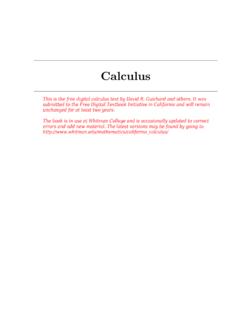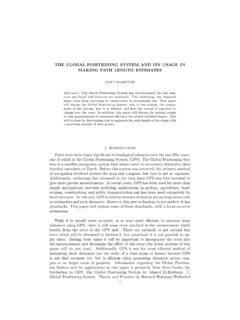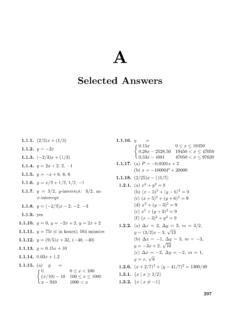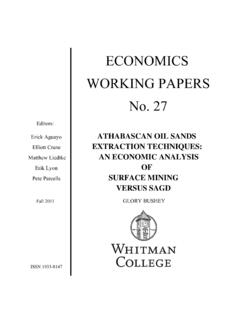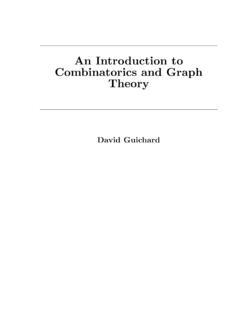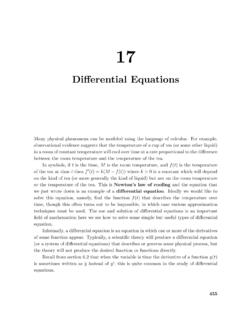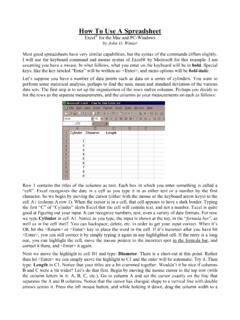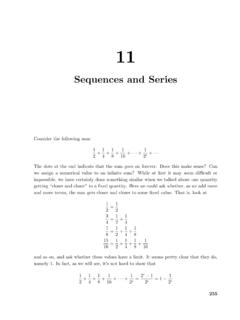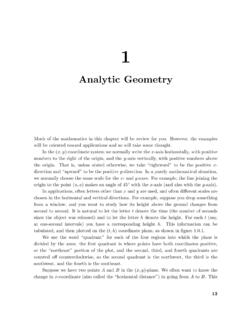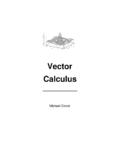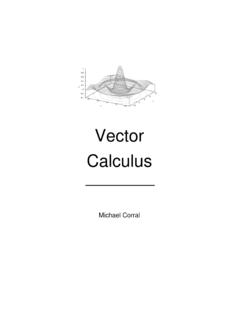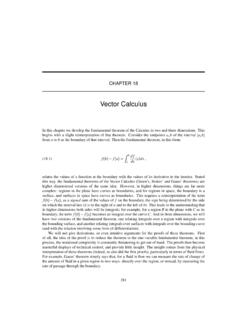Transcription of Vector Calculus
1 16 Vector torFieldsThis chapter is concerned with applying Calculus in the context ofvector fields. Atwo-dimensional Vector field is a functionfthat maps each point (x, y) inR2to a two-dimensional vectorhu, vi, and similarly a three-dimensional Vector field maps (x, y, z) tohu, v, wi. Since a Vector has no position, we typically indicate a Vector field in graphicalform by placing the vectorf(x, y) with its tail at (x, y). Figure shows a represen-tation of the Vector fieldf(x, y) =h x/ x2+y2+ 4, y/ x2+y2+ 4i. For such a graphto be readable, the vectors must be fairly short, which is accomplished by using a differentscale for the vectors than for the axes. Such graphs are thus useful for understanding thesizes of the vectors relative to each other but not their absolute fields have many important applications, as they can be used to represent manyphysical quantities: the Vector at a point may represent thestrength of some force (gravity,electricity, magnetism) or a velocity (wind speed or the velocity of some other fluid).
2 We have already seen a particularly important kind of vectorfield the gradient. Givena functionf(x, y), recall that the gradient ishfx(x, y), fy(x, y)i, a Vector that depends on(is a function of)xandy. We usually picture the gradient Vector with its tail at (x, y),pointing in the direction of maximum increase. Vector fieldsthat are gradients have someparticularly nice properties, as we will see. An important example isF= x(x2+y2+z2)3/2, y(x2+y2+z2)3/2, z(x2+y2+z2)3/2 ,419420 Chapter 16 Vector Calculus Vector points from the point (x, y, z) toward the origin and has length x2+y2+z2(x2+y2+z2)3/2=1( x2+y2+z2)2,which is the reciprocal of the square of the distance from (x, y, z) to the origin in otherwords,Fis an inverse square law.
3 The vectorFis a gradient:F= 1 x2+y2+z2,( )which turns out to be extremely the Vector fields; check your work with Sage , x, , , ,1 + 1, x+ equation Line have so far integrated over intervals, areas, and volumes with single, double, andtriple integrals. We now investigate integration over or along a curve line integrals are really curve integrals .As with other integrals, a geometric example may be easiest to understand. Considerthe functionf=x+yand the parabolay=x2in thex-yplane, for 0 x 2. Imaginethat we extend the parabola up to the surfacef, to form a curved wall or curtain, as infigure What is the area of the surface thus formed? We already know one way tocompute surface area, but here we take a different approach that is more useful for theproblems to the area under a curve.
4 (AP)As usual, we start by thinking about how to approximate the area. We pick somepoints along the part of the parabola we re interested in, and connect adjacent points bystraight lines; when the points are close together, the length of each line segment will beclose to the length along the parabola. Using each line segment as the base of a rectangle,we choose the height to be the height of the surfacefabove the line segment. If we addup the areas of these rectangles, we get an approximation to the desired area, and in thelimit this sum turns into an the curve is in Vector form, or can easily be put in Vector form; in thisexample we havev(t) =ht, t2i. Then as we have seen in section on arc length,the length of one of the straight line segments in the approximation is approximately422 Chapter 16 Vector Calculusds=|v |dt= 1 + 4t2dt, so the integral is 20f(t, t2) 1 + 4t2dt= 20(t+t2) 1 + 4t2dt=16748 17 112 164ln(4 + 17).
5 This integral of a function along a curveCis often written in abbreviated form as Cf(x, y) CyexdswhereCis the line segment from (1,2) to (4,7).We write the line segment as a Vector function:v=h1,2i+th3,5i, 0 t 1, or inparametric formx= 1 + 3t,y= 2 + 5t. Then Cyexds= 10(2 + 5t)e1+3t 32+ 52dt=169 34e4 19 of these ideas extend to three dimensions in the obvious Cx2z dswhereCis the line segment from (0,6, 1) to(4,1,5).We write the line segment as a Vector function:v=h0,6, 1i+th4, 5,6i, 0 t 1,or in parametric formx= 4t,y= 6 5t,z= 1 + 6t. Then Cx2z ds= 10(4t)2( 1 + 6t) 16 + 25 + 36dt= 16 77 10 t2+ 6t3dt=563 we turn to a perhaps more interesting example. Recall that in the simplest case,the work done by a force on an object is equal to the magnitude of the force times thedistance the object moves; this assumes that the force is constant and in the direction ofmotion.
6 We have already dealt with examples in which the force is not constant; now weare prepared to examine what happens when the force is not parallel to the direction Line Integrals423We have already examined the idea of components of force, in example : thecomponent of a forceFin the direction of a vectorvisF v|v|2v,the projection ofFontov. The length of this Vector , that is, the magnitude of the forcein the direction ofv, isF v|v|,the scalar projection ofFontov. If an object moves subject to this (constant) force, inthe direction ofv, over a distance equal to the length ofv, the work done isF v|v||v|=F , work in the Vector setting is still force times distance , except that times means dot product.
7 If the force varies from point to point, it is represented by avector fieldF; the dis-placement vectorvmay also change, as an object may follow a curving path in two orthree dimensions. Suppose that the path of an object is givenby a Vector functionr(t); atany point along the path, the (small) tangent vectorr tgives an approximation to itsmotion over a short time t, so the work done during that time is approximatelyF r t;the total work over some time period is then t1t0F r is useful to rewrite this in various ways at different times. We start with t1t0F r dt= CF dr,abbreviatingr dtbydr. Or we can write t1t0F r dt= t1t0F r |r ||r |dt= t1t0F T|r |dt= CF Tds,using the unit tangent vectorT, abbreviating|r |dtasds, and indicating the path of theobject byC.
8 In other words, work is computed using a particular line integral of the form424 Chapter 16 Vector Calculuswe have considered. Alternately, we sometimes write CF r dt= Chf, g, hi hx , y , z idt= C(fdxdt+gdydt+hdzdt)dt= Cf dx+g dy+h dz= Cf dx+ Cg dy+ Ch dz,and similarly for two dimensions, leaving out references an object moves from ( 1,1) to (2,4) along the pathr(t) =ht, t2i, subject to the forceF=hxsiny, yi. Find the work can write the force in terms oftashtsin(t2), t2i, and computer (t) =h1,2ti, andthen the work is 2 1htsin(t2), t2i h1,2tidt= 2 1tsin(t2) + 2t3dt=152+cos(1) cos(4) , we might write Cxsiny dx+ Cy dy= 2 1xsin(x2)dx+ 41y dy= cos(4)2+cos(1)2+162 12getting the same Cxy2dsalong the line segment from (1,2,0) to (2,1,3).
9 Csinx dsalong the line segment from ( 1,2,1) to (1,2,5). Czcos(xy)dsalong the line segment from (1,0,1) to (2,2,3). Csinx dx+cosy dyalong the top half of the unit circle, from (1,0) to ( 1,0). Cxeydx+x2y dyalong the line segmenty= 3, 0 x 2. Cxeydx+x2y dyalong the line segmentx= 4, 0 y 4. Cxeydx+x2y dyalong the curvex= 3t,y=t2, 0 t 1. Cxeydx+x2y dyalong the curvehet, eti, 1 t 1. Chcosx,sinyi dralong the curveht, ti, 0 t 1. The Fundamental Theorem of Line Ch1/xy,1/(x+y)i dralong the path from (1,1) to (3,1) to (3,6) using straightline segments. Ch1/xy,1/(x+y)i dralong the curveh2t,5ti, 1 t 4. Ch1/xy,1/(x+y)i dralong the curveht, t2i, 1 t 4. Cyz dx+xz dy+xy dzalong the curveht, t2, t3i, 0 t 1.
10 Cyz dx+xz dy+xy dzalong the curvehcost,sint,tanti, 0 t . object moves from (1,1) to (4,8) along the pathr(t) =ht2, t3i, subject to the forceF=hx2,sinyi. Find the work done. object moves along the line segment from (1,1) to (2,5), subject to the forceF=hx/(x2+y2), y/(x2+y2)i. Find the work done. object moves along the parabolar(t) =ht, t2i, 0 t 1, subject to the forceF=h1/(y+ 1), 1/(x+ 1)i. Find the work done. object moves along the line segment from (0,0,0) to (3,6,10), subject to the forceF=hx2, y2, z2i. Find the work done. object moves along the curver(t) =h t,1/ t, ti1 t 4, subject to the forceF=hy, z, xi. Find the work done. object moves from (1,1,1) to (2,4,8) along the pathr(t) =ht, t2, t3i, subject to the forceF=hsinx,siny,sinzi.
